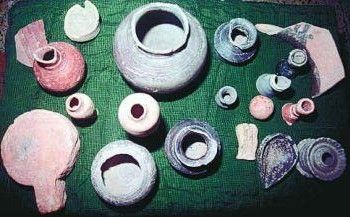Job Charnock is credited with having founded Calcutta, now Kolkata, in 1690. It was the capital of the British Indian empire until 1911 when the capital was relocated to Delhi. The word Kolkata derives from the Bengali term Kôlikata, the name of one of three villages that predated the arrival of the British, in the area where the city eventually was to be established; the other two villages were Sutanuti and Govindapur. But artifacts unearthed during a recent excavation could rewrite the history of the origins of this city.
Recent excavations, at the famous Dum Dum mound, which houses the Clive House — the oldest building in the city — have yielded remains of an urban settlement dating back to 2nd Century BC, which proved that urban settlements existed in Kolkata long before a colonial town came up in the triad of villages of Kalikata, Sutanuti and Gobindapur. The site remained in occupation almost till modern time, with a break during the 12th to 14th Century AD.
Artefacts from the excavation are various and include exquisite terracotta plaques and figures from the 2nd and 1st Century BC to 8th-9th Century AD. This excavation has proved that Kolkata was inhabited by civilised people who used materials normally found in an urban settlement. The discovery of various things bearing close resemblance at many artefacts that hints that the settlement was an extension of Chandraketugarh.
Chandraketugarh is an archaeological site located about 35 km north-east of Kolkata, where archaeologists discovered many artefacts dated from 400 BC to 100 BC. According to some historians, the Chandraketugarh site and surrounding area could be the place known to ancient Greek and Roman writers as ‘Gangaridai‘.
“The excavation revealed that Kolkata did not spring up suddenly. Traces of urban settlement found during the excavation bore a close resemblance with those found in an urban settlement at Chandraketugarh,” said ASI (Archaeology Survey of India) regional director P K Mishra.
There could have been more revelations if the ASI could complete the excavation. Archaeologists believe that the revelations will not only give a complete understanding of the origins of Kolkata, but they may as well unearth a whole city. But much progress could not be made as the site is surrounded by a densely populated urban centre and further excavation could risk damaging nearby buildings.
“An extensive excavation is required to understand the real history of the city. But whatever we have found is enough to rewrite the history of the city,” claimed Mishra.
Though evacuation of this site started as late as 2001, ASI officials came to understand its importance by chance, when a telecom company digging for laying cables dug up a plaque with inscriptions.
Featured Image: by Sushanta Patronobish
Source:
Chandraketugarh: A history of ancient and medieval India
Dum Dum mound may rewrite Kolkata history: Times of india



